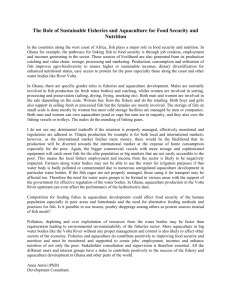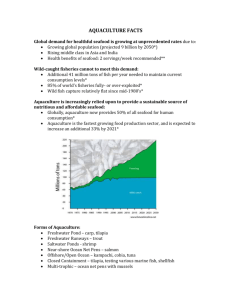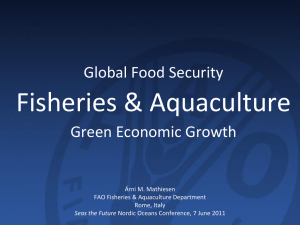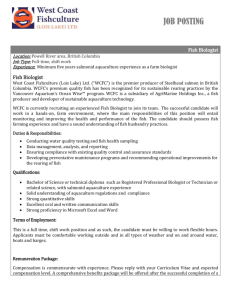Public Hearing Summary - Gulf of Mexico Fishery Management
advertisement
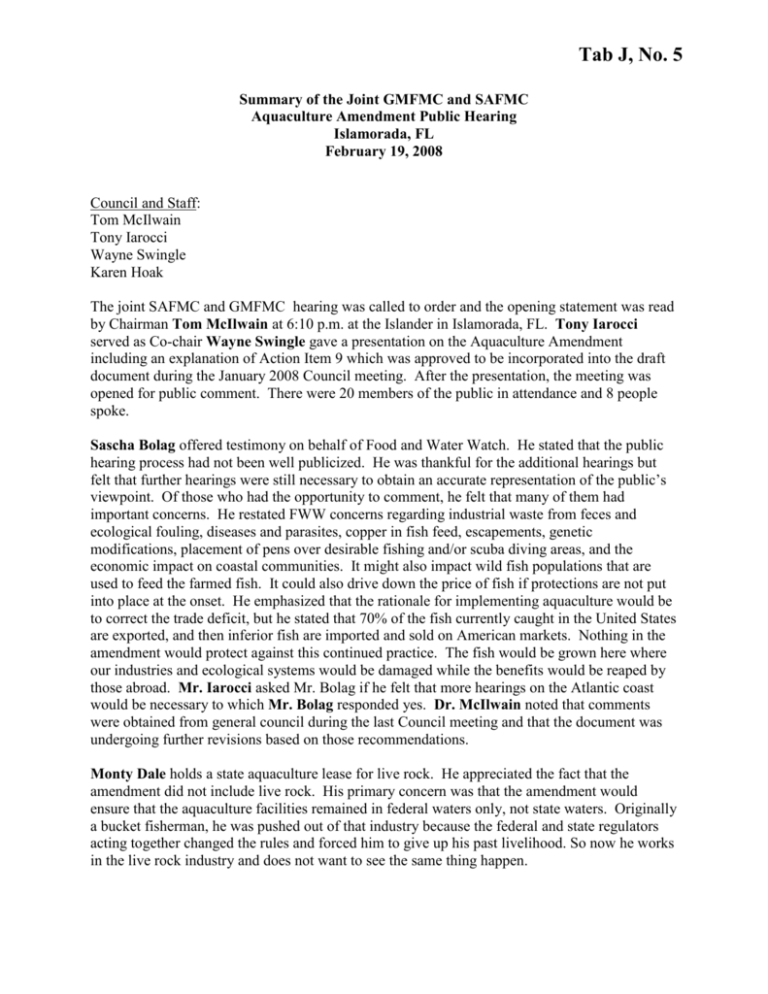
Tab J, No. 5 Summary of the Joint GMFMC and SAFMC Aquaculture Amendment Public Hearing Islamorada, FL February 19, 2008 Council and Staff: Tom McIlwain Tony Iarocci Wayne Swingle Karen Hoak The joint SAFMC and GMFMC hearing was called to order and the opening statement was read by Chairman Tom McIlwain at 6:10 p.m. at the Islander in Islamorada, FL. Tony Iarocci served as Co-chair Wayne Swingle gave a presentation on the Aquaculture Amendment including an explanation of Action Item 9 which was approved to be incorporated into the draft document during the January 2008 Council meeting. After the presentation, the meeting was opened for public comment. There were 20 members of the public in attendance and 8 people spoke. Sascha Bolag offered testimony on behalf of Food and Water Watch. He stated that the public hearing process had not been well publicized. He was thankful for the additional hearings but felt that further hearings were still necessary to obtain an accurate representation of the public’s viewpoint. Of those who had the opportunity to comment, he felt that many of them had important concerns. He restated FWW concerns regarding industrial waste from feces and ecological fouling, diseases and parasites, copper in fish feed, escapements, genetic modifications, placement of pens over desirable fishing and/or scuba diving areas, and the economic impact on coastal communities. It might also impact wild fish populations that are used to feed the farmed fish. It could also drive down the price of fish if protections are not put into place at the onset. He emphasized that the rationale for implementing aquaculture would be to correct the trade deficit, but he stated that 70% of the fish currently caught in the United States are exported, and then inferior fish are imported and sold on American markets. Nothing in the amendment would protect against this continued practice. The fish would be grown here where our industries and ecological systems would be damaged while the benefits would be reaped by those abroad. Mr. Iarocci asked Mr. Bolag if he felt that more hearings on the Atlantic coast would be necessary to which Mr. Bolag responded yes. Dr. McIlwain noted that comments were obtained from general council during the last Council meeting and that the document was undergoing further revisions based on those recommendations. Monty Dale holds a state aquaculture lease for live rock. He appreciated the fact that the amendment did not include live rock. His primary concern was that the amendment would ensure that the aquaculture facilities remained in federal waters only, not state waters. Originally a bucket fisherman, he was pushed out of that industry because the federal and state regulators acting together changed the rules and forced him to give up his past livelihood. So now he works in the live rock industry and does not want to see the same thing happen. Dale Perez with the Florida Keys Guides Association has worked as a guide for 40 years. His concerns involved the placement of pens. From Biscayne Bay through Key West, there is a $1.4 billion per year industry that could be negatively impacted by pens if they are placed too close to the coastal waters. Reefs and Florida Bay could be damaged by effluents from the pens and the subsequent algae blooms. He recommended that they stay well offshore so as to not affect the coastal habitat. Marianne Cufone of Food and Water Watch reviewed the history of the aquaculture plan. She commented that the Gulf Council had been talking about aquaculture since 2003 when Joe Hendrix was appointed to the Council. Mr. Hendrix is an aquaculturist and she stated that he has been the driving force behind the idea of offshore aquaculture. The Gulf and South Atlantic Councils both created a policy on offshore aquaculture. She commented that that the South Atlantic created a wonderful aquaculture policy in June 2007 which protected habitat. She noted that some of the species proposed for farming were jointly managed by both Councils and that was why we were now conducting joint meetings on the subject. She encouraged more South Atlantic hearings. The current plan, started in 2003 stalled in 2005 because of actions by Congress to establish a national aquaculture act. That plan also stalled so the Gulf Council resumed its work on the Gulf Council plan in January 2007. She stated that this plan was supposed to be approved by October 2007. Normally, things that have a legal mandate require a great amount of time, sometimes years, but since this had no legal mandate the Council tried to do it in 9 months. She reiterated that Council members with interests in aquaculture were helping the document through the process. She agreed with comments made by Mr. Bolag and stated that things missing in the document were a concern to her. For one thing, the citing criteria were to be determined on a case by case basis. The only specific was that they would be between 3 and 200 miles offshore. They could be placed on spawning grounds, fishing grounds, diving areas, or habitats of particular concern. She recommended zoning the areas that could be used. She also commented that Council cannot regulate drugs, feed, or what pollution can and cannot come out of a facility. A memorandum of understanding would have to be created between the Council and the EPA (she mentioned that she was a lawyer). NOAA counsel noted that there were legal problems that need to be addressed before the document could move forward. All agencies that have jurisdiction in federal waters should be involved before approval. The plan came a long way since its inception but it still needed much more refinement and she encouraged further dialog and refinement from all interested parties. Mr. Iarocci requested that those who felt there should be more public hearings in the South Atlantic region should state that for the record. Mr. Swingle pointed out that final action could not occur until at least the June meeting, so there was adequate time to hold more meetings, if required. Simon Stafford, a commercial fisherman in Key West proposed inserting water quality monitoring language under Action 8 including parameters for acceptable water degradation. As a commercial fisherman, he wanted to see farm-raised fish labeled as such when they are sold. He asked whether only species that fell under a FMP could be farmed or if sponges and the like could also be grown. Wayne Swingle answered that only managed species may be farmed. Bill Kelly, a fishing guide of 31 years was cautiously optimistic. He understood the advantages of finding alternative methods for feeding an ever growing population. He also noted however that there was also a potential for catastrophe since the Gulfstream comes out of the Panhandle and down into the Keys. He has also recently noticed algae blooms that are more frequent and of longer duration. They are also confronting problems from sugar growers. Debris moves south. They are undergoing a 20 year management plan with the Everglades National Park. He was concerned about the level of interagency communication and activity and wondered if Dan Kimble was even aware of this proposal which could greatly impact Florida Bay. He wondered if foreigners would be welcome to participate and expressed concern about the possibility of farmed fish being exported while U.S. market needs went unmet. He wanted to know the economic impacts. He wondered how commercial, recreational, and environmental groups could ever agree on anything, while mooring and environmental damage from storms such as Katrina were also concerning. He wondered if a determination had been made about how many hectares would be allocated for placement of cages. Aaron Welch was a professional aquaculturist employed by the University of Miami experimental fish hatchery. First he addressed the boat captains’ concerns by commenting that the last thing aquaculturists would want to do is mess up the flats or any other recreational fishing grounds. A lot could be done to mitigate the farms’ impact. Regarding mooring, he noted that cages are amazing pieces of engineering. Two cages in Puerto Rico had both survived direct hits from a category 4 hurricane. Cages moored properly in deep enough water will survive. Regarding chemicals and antibiotic use, they shipped 140,000 cobia fingerlings without using one drop of antibiotics. He did not comprehend how administration would occur to a cage full of fish in the open ocean. He had seen operations in Puerto Rico and Panama first hand and knew that it can be done successfully. Regarding fouling from feed and feces, he felt that the pollution that came from cages was far less than what came out of metropolitan areas such as Miami. He noted that Boynton Beach puts out 100 tons of nitrogen and 100 tons of phosphorous every month. People pay no attention to pollution that comes out of golf courses and subdivisions. Escapements were possible, but through responsible genetic handling, an escapement would amount to nothing more than a stock enhancement. Modern aquaculture is not on par with the salmon industry of the 1970s and from his standpoint, comparing the two was not fair. Regarding price drops, he noted that the price of salmon had held up quite nicely, especially wild caught salmon and 20-30% of wild caught salmon comes from hatcheries. On the topic of feed, he stated that carnivorous fish would need to feed on bait fish. However, over the last 20 years, despite a 10% annual increase in aquaculture, the amount of fish harvested had remained steady at 20 to 25 mega tons per year. He extended an invitation to the participants to come to UM and see the hatchery and witness first-hand what was being proposed. He also commented that although many are concerned about the trade deficit, aquaculturists were the only ones taking constructive action to reverse it. Mimi Stafford had a background in marine biology and is currently involved in the commercial fishery. In the past she felt that aquaculture would be the answer to many of the world’s problems but has since developed some reservations. She expressed concerns about people’s lack of knowledge on the whole subject. Regardless of the pollution stemming from metro areas, new facilities will create still more pollution, which is a problem. She was also concerned about feed fish biomass reduction as well as citing criteria that would prevent displacement of current fishers. She inquired if a socioeconomic had yet been done to find out who would be affected by the plan. This was basically industrial farming, and just like land based farming, ocean based industrial farming would have consequences and she wondered if the level of return would be worth the price. She was concerned about Chinese basa and other imports that did not adhere to certain standards but felt managers should not rush into anything without taking into account all the varying factors. She supported another round of public hearings in the lower Keys. Mr. Iarocci proposed holding additional meetings, perhaps one in Key West and one in Key Largo or Miami. Dr. McIlwain read the closing statement and the meeting adjourned at 7:25 p.m.




